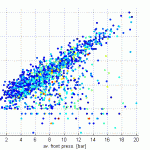Oct 6th, 2008 by Frank LaBanca, Ed.D.
 I taught a statistics class last Wednesday evening on correlation, and left feeling very depressed. I could see the level of frustration in some students’ eyes. They were working extremely hard, focusing, and were struggling immensely. These are no ordinary students: they are clearly some of the top educators in the region, all pursing a doctorate in instructional leadership.
I taught a statistics class last Wednesday evening on correlation, and left feeling very depressed. I could see the level of frustration in some students’ eyes. They were working extremely hard, focusing, and were struggling immensely. These are no ordinary students: they are clearly some of the top educators in the region, all pursing a doctorate in instructional leadership.
I had lost some students along the way, and I my reflection on the process leads me to believe that I didn’t stress the “big idea,” strong enough. What may have happened is that the students got caught in the idiosyncrasies of the mechanics of correlation. Certainly the content was extremely rigorous for some of the students. There was a high level of math concept connected to technical use of the computer to analyze data. In other words, we went from conceptual learning to learning about facts in isolation – always a bad way to go.
 What was the big idea in laymen’s terms? Is there a mathematical pattern or trend between two variables? The pattern or trend we were searching for was a linear relationship. So, if a set of points for one measure is compared to the set of points for another, do they plot out to produce an image that looks like a line? Once this line is ascertained, how accurate is it? In other words, do the points that were used to plot it have statistical significance?
What was the big idea in laymen’s terms? Is there a mathematical pattern or trend between two variables? The pattern or trend we were searching for was a linear relationship. So, if a set of points for one measure is compared to the set of points for another, do they plot out to produce an image that looks like a line? Once this line is ascertained, how accurate is it? In other words, do the points that were used to plot it have statistical significance?
I can certainly discuss the concept more, but what I want to focus on is concept acquisition, specifically as it relates to teaching and subsequent learning. When considering learning, Fischer, B.B. & Fischer L. (1979). (Styles in teaching and learning. Educational Leadership, 36, 4, 245) suggest that the environment generated by the teacher can be teaching centered, learning centered, or student centered. (There are actually several others, but I will limit for the purpose of this discussion.)
|
The child-centered
|
This teacher provides a structure for students to pursue whatever they want to do or whatever interests them. This style is not only extremely rare, it is almost impossible to imagine in its pure form because the classroom, with its adult-child ratio and adult-responsible environment, automatically encourages some interests and discourages others.
|
|
The subject-centered
|
These teachers focus on organized content to the near exclusion of the learner. By “covering the subject,” they satisfy the clearly delineated curricular requirements of the course.
|
|
The learning-centered
|
These teachers have equal concern for the students and for the curricular objectives, the materials to be learned. They reject the over-emphasis of both the “child-centered” and “subject-centered” styles and instead help students, whatever their abilities or disabilities, develop toward substantive goals as well as in their autonomy in learning.
|
When designing the class, I tried to design learning activities that would allow for some concept acquisition, followed by skill building activities to learn the techniques necessary for computer calculation of correlation. The activities were intended to be compartmentalized and chunked –learn a concept then apply it practically. I think I had planned my class as a learning-centered teacher, but as the class progressed, I think I transitioned more to a subject-centered teacher. I had allowed the content that I was obligated to cover, take over the responsibilities for the class, and mercilessly plowed along, to the dismay of some of the students. I think I would be remiss to mention that some students were with me without fail the whole time. I am struggling with the balance for all of the students.
The challenge for me is to meet the curricular requirements of the class while allowing students to grow to be autonomous quantitative educational researchers. It’s hard enough to be a teacher, let alone a teacher of teachers.
Probably the ironic part of the whole story is as I sit and beat myself up over my work, there are probably students doing the same thing to themselves. We’ll all grow together.